Optical, Electrical and Structural Properties of ITO/IZO and IZO/ITO Multilayer Transparent Conductive Oxide Films Deposited via Radiofrequency Magnetron Sputtering
Abstract
1. Introduction
2. Materials and Methods
3. Results and Discussion
3.1. Structural and Morphological Properties
3.2. Optical and Electrical Properties
4. Conclusions
Author Contributions
Funding
Institutional Review Board Statement
Informed Consent Statement
Data Availability Statement
Conflicts of Interest
References
- Xu, H.; Lan, L.; Xu, M.; Li, M.; Luo, D.; Xiao, P.; Peng, J. Low-Roughness and Easily-Etched Transparent Conducting Oxides with a Stack Structure of ITO and IZO. ECS J. Solid State Sci. Technol. 2013, 2, R245–R248. [Google Scholar] [CrossRef]
- Lee, D.; Lee, A.; Kim, H.-D. IZO/ITO Double-Layered Transparent Conductive Oxide for Silicon Heterojunction Solar Cells. IEEE Access 2022, 10, 77170–77175. [Google Scholar] [CrossRef]
- Gonçalves, G.; Elangovan, E.; Barquinha, P.; Pereira, L.; Martins, R.; Fortunato, E. Influence of Post-Annealing Temperature on the Properties Exhibited by ITO, IZO and GZO Thin Films. Thin Solid Film. 2007, 515, 8562–8566. [Google Scholar] [CrossRef]
- Raniero, L.; Ferreira, I.; Pimentel, A.; Gonçalves, A.; Canhola, P.; Fortunato, E.; Martins, R. Role of Hydrogen Plasma on Electrical and Optical Properties of ZGO, ITO and IZO Transparent and Conductive Coatings. Thin Solid Film. 2006, 511–512, 295–298. [Google Scholar] [CrossRef]
- Jeong, J.-A.; Choi, K.-H.; Bae, J.-H.; Moon, J.-M.; Jeong, S.W.; Kim, I.; Kim, H.-K.; Yi, M.-S. Electrical, Optical, and Structural Properties of ITO Co-Sputtered IZO Films by Dual Target Magnetron Sputtering. J. Electroceramics 2009, 23, 361–366. [Google Scholar] [CrossRef]
- Sasabayashi, T.; Song, P.K.; Shigesato, Y.; Utsumi, K.; Kaijo, A.; Mitsui, A. Internal Stress of ITO, IZO and GZO Films Deposited by RF and DC Magnetron Sputtering. MRS Proc. 2001, 666, F2.4. [Google Scholar] [CrossRef]
- Kim, S.M.; Park, S.J.; Yoon, H.H.; Choi, H.W.; Kim, K.H. Preparation of ITO and IZO Thin Films by Using Facing Target Sputtering (FTS) Method. J. Korean Phy. Soc. 2009, 55, 1996–2001. [Google Scholar] [CrossRef]
- Morales-Masis, M.; Martin De Nicolas, S.; Holovsky, J.; De Wolf, S.; Ballif, C. Low-Temperature High-Mobility Amorphous IZO for Silicon Heterojunction Solar Cells. IEEE J. Photovolt. 2015, 5, 1340–1347. [Google Scholar] [CrossRef]
- Akdemir, O.; Zolfaghari Borra, M.; Nasser, H.; Turan, R.; Bek, A. MoO x /Ag/MoO x Multilayers as Hole Transport Transparent Conductive Electrodes for N-type Crystalline Silicon Solar Cells. Int. J. Energy Res. 2020, 44, 3098–3109. [Google Scholar] [CrossRef]
- Tsai, D.-C.; Chang, Z.-C.; Kuo, B.-H.; Wang, Y.-H.; Chen, E.-C.; Shieu, F.-S. Thickness Dependence of the Structural, Electrical, and Optical Properties of Amorphous Indium Zinc Oxide Thin Films. J. Alloys Compd. 2018, 743, 603–609. [Google Scholar] [CrossRef]
- Wang, F.; Wu, M.Z.; Wang, Y.Y.; Yu, Y.M.; Wu, X.M.; Zhuge, L.J. Influence of Thickness and Annealing Temperature on the Electrical, Optical and Structural Properties of AZO Thin Films. Vacuum 2013, 89, 127–131. [Google Scholar] [CrossRef]
- Lin, S.-S.; Huang, J.-L.; Lii, D.-F. The Effect of Thickness on the Properties of Ti-Doped ZnO Films by Simultaneous r.f. and d.c. Magnetron Sputtering. Surf. Coat. Technol. 2005, 190, 372–377. [Google Scholar] [CrossRef]
- Kuo, C.-C.; Liu, C.-C.; He, S.-C.; Chang, J.-T.; He, J.-L. The Influences of Thickness on the Optical and Electrical Properties of Dual-Ion-Beam Sputtering-Deposited Molybdenum-Doped Zinc Oxide Layer. J. Nanomater. 2011, 2011, 140697. [Google Scholar] [CrossRef]
- Seyhan, A.; Altan, T.; Ecer, Ö.C.; Zan, R. A Hydrogenated Amorphous Silicon (a-Si:H) Thin Films for Heterojunction Solar Cells: Structural and Optical Properties. J. Phys. Conf. Ser. 2017, 902, 012024. [Google Scholar] [CrossRef]
- Zdorovets, M.V.; Kozlovskiy, A.L.; Borgekov, D.B.; Shlimas, D.I. Influence of Irradiation with Heavy Kr15+ Ions on the Structural, Optical and Strength Properties of BeO Ceramic. J. Mater. Sci. Mater. Electron. 2021, 32, 15375–15385. [Google Scholar] [CrossRef]
- Trukhanov, S.V. Peculiarities of the magnetic state in the system La0.70Sr0.30MnO3−γ (0 ≤ γ ≤ 0.25). Exp. Theor. Phys. 2005, 100, 95–105. [Google Scholar] [CrossRef]
- Panasyuk, M.I.; Zubar, T.I.; Usovich, T.I.; Tishkevich, D.I.; Kanafyev, O.D.; Fedkin, V.A.; Kotelnikova, A.N.; Trukhanov, S.V.; Michels, D.; Lyakhov, D.; et al. Mechanism of Bubbles Formation and Anomalous Phase Separation in the CoNiP System. Sci. Rep. 2023, 13, 5829. [Google Scholar] [CrossRef]
- Tuleushev, A.Z.; Harrison, F.E.; Kozlovskiy, A.L.; Zdorovets, M.V. Evolution of the Absorption Edge of PET Films Irradiated with Kr Ions after Thermal Annealing and Ageing. Opt. Mater. 2021, 119, 111348. [Google Scholar] [CrossRef]
- Ferreira, A.A.; Silva, F.J.G.; Pinto, A.G.; Sousa, V.F.C. Characterization of Thin Chromium Coatings Produced by PVD Sputtering for Optical Applications. Coatings 2021, 11, 215. [Google Scholar] [CrossRef]
- Ravichandran, K.; Anandhi, R.; Sakthivel, B.; Swaminathan, K.; Ravikumar, P.; Begum, N.J.; Snega, S. Thickness Dependence of FTO Over-Layer on Properties of FTO/FZO Bilayer. Mater. Manuf. Process. 2013, 28, 1322–1326. [Google Scholar] [CrossRef]
- Keleş, F.; Kartal, E.; Seyhan, A. Yüksek Basınç Saçtırma Yönteminin Yoğunluk Modülasyonlu İTO İnce Filmlerin Optik Özelliklerine Etkisinin İncelenmesi. Selçuk Üniversitesi Fen Fakültesi Fen Derg. 2019, 45, 197–208. [Google Scholar] [CrossRef][Green Version]
- Kartal, E.; Duran, İ.; Damgaci, E.; Seyhan, A. Investigation Of Structural, Optical, And Electrical Properties Of Ito Films Deposited At Different Plasma Powers: Enhanced Performance And Efficiency In SHJ Solar Cells. Eurasian J. Sci. Eng. Technol. 2023, 4, 25–35. [Google Scholar] [CrossRef]
- Shin, D.; Shin, J.H.; Lee, H.Y.; Lee, J.-Y.; Lee, S.-J. Characteristics of IZO/AZO and AZO/IZO Bi-Layer Transparent Conducting Thin Films Prepared by Using PLD. J. Korean Phys. Soc. 2012, 60, 1662–1665. [Google Scholar] [CrossRef]
- Montero, J.; Guillén, C.; Herrero, J. AZO/ATO Double-Layered Transparent Conducting Electrode: A Thermal Stability Study. Thin Solid Film. 2011, 519, 7564–7567. [Google Scholar] [CrossRef]
- Mahmood, K.; Munir, R.; Kang, H.W.; Sung, H.J. An Atmospheric Pressure-Based Electrospraying Route to Fabricate the Multi-Applications Bilayer (AZO/ITO) TCO Films. RSC Adv. 2013, 3, 25741. [Google Scholar] [CrossRef]
- Ponja, S.D.; Sathasivam, S.; Parkin, I.P.; Carmalt, C.J. Highly Conductive and Transparent Gallium Doped Zinc Oxide Thin Films via Chemical Vapor Deposition. Sci. Rep. 2020, 10, 638. [Google Scholar] [CrossRef] [PubMed]
- Chen, T.-H.; Jian, B.-L. Optical and Electronic Properties of Mo:ZnO Thin Films Deposited Using RF Magnetron Sputtering with Different Process Parameters. Opt. Quant. Electron. 2016, 48, 77. [Google Scholar] [CrossRef]
- Park, H.; Lee, J.; Kim, H.; Kim, D.; Raja, J.; Yi, J. Influence of SnO2:F/ZnO:Al Bi-Layer as a Front Electrode on the Properties of p-i-n Amorphous Silicon Based Thin Film Solar Cells. Appl. Phys. Lett. 2013, 102, 191602. [Google Scholar] [CrossRef]
- Szafraniak, B.; Fuśnik, Ł.; Xu, J.; Gao, F.; Brudnik, A.; Rydosz, A. Semiconducting Metal Oxides: SrTiO3, BaTiO3 and BaSrTiO3 in Gas-Sensing Applications: A Review. Coatings 2021, 11, 185. [Google Scholar] [CrossRef]
- Shaheera, M.; Girija, K.G.; Kaur, M.; Geetha, V.; Debnath, A.K.; Vatsa, R.K.; Muthe, K.P.; Gadkari, S.C. Characterization and Device Application of Indium Doped ZnO Homojunction Prepared by RF Magnetron Sputtering. Opt. Mater. 2020, 101, 109723. [Google Scholar] [CrossRef]
- Hong, C.H.; Jo, Y.J.; Kim, H.A.; Lee, I.-H.; Kwak, J.S. Effect of Electron Beam Irradiation on the Electrical and Optical Properties of ITO/Ag/ITO and IZO/Ag/IZO Films. Thin Solid Film. 2011, 519, 6829–6833. [Google Scholar] [CrossRef]
- Sofi, A.H.; Shah, M.A.; Asokan, K. Structural, Optical and Electrical Properties of ITO Thin Films. J. Electron. Mater. 2018, 47, 1344–1352. [Google Scholar] [CrossRef]
- Fallah, H.R.; Ghasemi, M.; Hassanzadeh, A. Influence of Heat Treatment on Structural, Electrical, Impedance and Optical Properties of Nanocrystalline ITO Films Grown on Glass at Room Temperature Prepared by Electron Beam Evaporation. Phys. E: Low-Dimens. Syst. Nanostruct. 2007, 39, 69–74. [Google Scholar] [CrossRef]
- Alam, M.J.; Cameron, D.C. Optical and Electrical Properties of Transparent Conductive ITO Thin Films Deposited by Sol–Gel Process. Thin Solid Film. 2000, 377–378, 455–459. [Google Scholar] [CrossRef]
- Ito, N.; Sato, Y.; Song, P.K.; Kaijio, A.; Inoue, K.; Shigesato, Y. Electrical and Optical Properties of Amorphous Indium Zinc Oxide Films. Thin Solid Film. 2006, 496, 99–103. [Google Scholar] [CrossRef]
- Kacha, K.; Djeffal, F.; Ferhati, H.; Foughali, L.; Bendjerad, A.; Benhaya, A.; Saidi, A. Efficiency Improvement of CIGS Solar Cells Using RF Sputtered TCO/Ag/TCO Thin-Film as Prospective Buffer Layer. Ceram. Int. 2022, 48, 20194–20200. [Google Scholar] [CrossRef]
- Ghasemi, H.; Mozaffari, M.H.; Moradian, R.; Ghobadi, N. Optical and Electrical Properties of ITO/Metal/NiO Triple-Layer Grown by PVD Method: An Experimental Study. Mater. Sci. Semicond. Process. 2022, 149, 106853. [Google Scholar] [CrossRef]
- Wang, J.; Meng, C.; Liu, H.; Hu, Y.; Zhao, L.; Wang, W.; Xu, X.; Zhang, Y.; Yan, H. Application of Indium Tin Oxide/Aluminum-Doped Zinc Oxide Transparent Conductive Oxide Stack Films in Silicon Heterojunction Solar Cells. ACS Appl. Energy Mater. 2021, 4, 13586–13592. [Google Scholar] [CrossRef]
- Wang, M.; He, Y.; Da Rocha, M.; Rougier, A.; Diao, X. Temperature Dependence of the Electrochromic Properties of Complementary NiO//WO3 Based Devices. Sol. Energy Mater. Sol. Cells 2021, 230, 111239. [Google Scholar] [CrossRef]
- Altuntepe, A.; Olgar, M.A.; Erkan, S.; Hasret, O.; Keçeci, A.E.; Kökbudak, G.; Tomakin, M.; Seyhan, A.; Turan, R.; Zan, R. Hybrid Transparent Conductive Electrode Structure for Solar Cell Application. Renew. Energy 2021, 180, 178–185. [Google Scholar] [CrossRef]
- Zan, R.; Olgar, M.A.; Altuntepe, A.; Seyhan, A.; Turan, R. Integration of Graphene with GZO as TCO Layer and Its Impact on Solar Cell Performance. Renew. Energy 2022, 181, 1317–1324. [Google Scholar] [CrossRef]
- Kozlovskiy, A.L.; Shlimas, D.I.; Zdorovets, M.V. Synthesis, Structural Properties and Shielding Efficiency of Glasses Based on TeO2-(1-x)ZnO-XSm2O3. J. Mater. Sci: Mater. Electron. 2021, 32, 12111–12120. [Google Scholar] [CrossRef]
- Henaish, A.M.; Darwish, M.A.; Hemeda, O.M.; Weinstein, I.A.; Soliman, T.S.; Trukhanov, A.V.; Trukhanov, S.V.; Zhou, D.; Dorgham, A.M. Structure and Optoelectronic Properties of Ferroelectric PVA-PZT Nanocomposites. Opt. Mater. 2023, 138, 113402. [Google Scholar] [CrossRef]
- Liu, C.-C.; Liang, Y.-C.; Kuo, C.-C.; Liou, Y.-Y.; Chen, J.-W.; Lin, C.-C. Fabrication and Opto-Electric Properties of ITO/ZnO Bilayer Films on Polyethersulfone Substrates by Ion Beam-Assisted Evaporation. Sol. Energy Mater. Sol. Cells 2009, 93, 267–272. [Google Scholar] [CrossRef]
- Rezaie, M.N.; Manavizadeh, N.; Abadi, E.M.N.; Nadimi, E.; Boroumand, F.A. Comparison Study of Transparent RF-Sputtered ITO/AZO and ITO/ZnO Bilayers for near UV-OLED Applications. Appl. Surf. Sci. 2017, 392, 549–556. [Google Scholar] [CrossRef]
- Gong, L.; Lu, J.; Ye, Z. Room-Temperature Growth and Optoelectronic Properties of GZO/ZnO Bilayer Films on Polycarbonate Substrates by Magnetron Sputtering. Sol. Energy Mater. Sol. Cells 2010, 94, 1282–1285. [Google Scholar] [CrossRef]
- Murugesan, M.; Arjunraj, D.; Mayandi, J.; Venkatachalapathy, V.; Pearce, J.M. Properties of Al-Doped Zinc Oxide and In-Doped Zinc Oxide Bilayer Transparent Conducting Oxides for Solar Cell Applications. Mater. Lett. 2018, 222, 50–53. [Google Scholar] [CrossRef]
- Qiu, Q.; Bai, Y.; Li, J.; Guo, C.; Chen, H.; Zhang, H.; Shi, J.; Liu, W.; Chen, T.; Liao, J.; et al. ZnO-Doped In 2 O 3 Front Transparent Contact Enables >24.0% Silicon Heterojunction Solar Cells. Energy Technol. 2023, 11, 2201310. [Google Scholar] [CrossRef]
- Sittinger, V.; King, H.; Kaiser, A.; Jung, S.; Kabakli, Ö.Ş.; Schulze, P.S.C.; Goldschmidt, J.C. Indium-Based Transparent Conductive Oxides Developed for Perovskite and Perovskite-Silicon Tandem Solar Cell Applications. Surf. Coat. Technol. 2023, 457, 129286. [Google Scholar] [CrossRef]
- Zahid, M.A.; Khokhar, M.Q.; Park, S.; Hussain, S.Q.; Kim, Y.; Yi, J. Influence of Al2O3/IZO Double-Layer Antireflective Coating on the Front Side of Rear Emitter Silicon Heterojunction Solar Cell. Vacuum 2022, 200, 110967. [Google Scholar] [CrossRef]
- Lee, J.-A.; Lee, J.-H.; Heo, Y.-W.; Kim, J.-J.; Lee, H.Y. Characteristics of Sn and Zn Co-Substituted In2O3 Thin Films Prepared by RF Magnetron Sputtering. Curr. Appl. Phys. 2012, 12, S89–S93. [Google Scholar] [CrossRef]
- Park, J.H.; Park, H.K.; Jeong, J.; Kim, W.; Min, B.K.; Do, Y.R. Wafer-Scale Growth of ITO Nanorods by Radio Frequency Magnetron Sputtering Deposition. J. Electrochem. Soc. 2011, 158, K131. [Google Scholar] [CrossRef]
- Lien, S.-Y. Characterization and Optimization of ITO Thin Films for Application in Heterojunction Silicon Solar Cells. Thin Solid Film. 2010, 518, S10–S13. [Google Scholar] [CrossRef]
- Ogi, T.; Hidayat, D.; Iskandar, F.; Purwanto, A.; Okuyama, K. Direct Synthesis of Highly Crystalline Transparent Conducting Oxide Nanoparticles by Low Pressure Spray Pyrolysis. Adv. Powder Technol. 2009, 20, 203–209. [Google Scholar] [CrossRef]
- Zhang, K.; Zhu, F.; Huan, C.H.A.; Wee, A.T.S. Effect of Hydrogen Partial Pressure on Optoelectronic Properties of Indium Tin Oxide Thin Films Deposited by Radio Frequency Magnetron Sputtering Method. J. Appl. Phys. 1999, 86, 974–980. [Google Scholar] [CrossRef]
- Thilakan, P.; Kumar, J. Studies on the Preferred Orientation Changes and Its Influenced Properties on IT0 Thin Films. Vacuum 1997, 48, 463–466. [Google Scholar] [CrossRef]
- Meng, L.; dos Santos, M.P. Properties of Indium Tin Oxide Films Prepared by Rf Reactive Magnetron Sputtering at Different Substrate Temperature. Thin Solid Film. 1998, 322, 56–62. [Google Scholar] [CrossRef]
- Fortunato, E.; Pimentel, A.; Gonçalves, A.; Marques, A.; Martins, R. High Mobility Amorphous/Nanocrystalline Indium Zinc Oxide Deposited at Room Temperature. Thin Solid Film. 2006, 502, 104–107. [Google Scholar] [CrossRef]
- Butt, M.Z.; Ali, D.; Aftab, M.; Tanveer, M.U. Surface Topography and Structure of Laser-Treated High-Purity Zinc. Surf. Topogr.: Metrol. Prop. 2015, 3, 035002. [Google Scholar] [CrossRef]
- Williamson, G.K.; Hall, W.H. X-Ray Line Broadening from Filed Aluminium and Wolfram. Acta Metall. 1953, 1, 22–31. [Google Scholar] [CrossRef]
- Butt, M.Z.; Ali, D.; Farooq, H.; Bashir, F. Structural, Electrical, and Mechanical Characteristics of Proton Beam Irradiated Al5086 Alloy. Phys. B Condens. Matter 2015, 456, 275–282. [Google Scholar] [CrossRef]
- Das, S.; Senapati, S.; Alagarasan, D.; Varadhrajaperumal, S.; Ganesan, R.; Naik, R. Thermal Annealing-Induced Transformation of Structural, Morphological, Linear, and Nonlinear Optical Parameters of Quaternary As 20 Ag 10 Te 10 Se 60 Thin Films for Optical Applications. ACS Appl. Opt. Mater. 2023, 1, 17–31. [Google Scholar] [CrossRef]
- Priyadarshini, P.; Das, S.; Alagarasan, D.; Ganesan, R.; Varadharajaperumal, S.; Naik, R. Observation of High Nonlinearity in Bi Doped BixIn35-xSe65 Thin Films with Annealing. Sci. Rep. 2021, 11, 21518. [Google Scholar] [CrossRef] [PubMed]
- Yudar, H.H.; Korkmaz, Ş.; Özen, S.; Şenay, V.; Pat, S. Surface and Optical Properties of Indium Tin Oxide Layer Deposition by RF Magnetron Sputtering in Argon Atmosphere. Appl. Phys. A 2016, 122, 748. [Google Scholar] [CrossRef]
- Raoufi, D.; Kiasatpour, A.; Fallah, H.R.; Rozatian, A.S.H. Surface Characterization and Microstructure of ITO Thin Films at Different Annealing Temperatures. Appl. Surf. Sci. 2007, 253, 9085–9090. [Google Scholar] [CrossRef]
- Wang, S.-K.; Lin, T.-C.; Jian, S.-R.; Juang, J.-Y.; Jang, J.S.-C.; Tseng, J.-Y. Effects of Post-Annealing on the Structural and Nanomechanical Properties of Ga-Doped ZnO Thin Films Deposited on Glass Substrate by Rf-Magnetron Sputtering. Appl. Surf. Sci. 2011, 258, 1261–1266. [Google Scholar] [CrossRef]
- Sahoo, D.; Sahoo, S.; Alagarasan, D.; Ganesan, R.; Varadharajaperumal, S.; Naik, R. Proton Ion Irradiation on As 40 Se 50 Sb 10 Thin Films: Fluence-Dependent Tuning of Linear–Nonlinear Optical Properties for Photonic Applications. ACS Appl. Electron. Mater. 2022, 4, 856–868. [Google Scholar] [CrossRef]
- Kim, H.-M.; Bae, K.; Sohn, S. Electronic and Optical Properties of Indium Zinc Oxide Thin Films Prepared by Using Nanopowder Target. Jpn. J. Appl. Phys. 2011, 50, 045801. [Google Scholar] [CrossRef]
- Jeon, J.-W.; Jeon, D.-W.; Sahoo, T.; Kim, M.; Baek, J.-H.; Hoffman, J.L.; Kim, N.S.; Lee, I.-H. Effect of Annealing Temperature on Optical Band-Gap of Amorphous Indium Zinc Oxide Film. J. Alloys Compd. 2011, 509, 10062–10065. [Google Scholar] [CrossRef]
- Haacke, G. New Figure of Merit for Transparent Conductors. J. Appl. Phys. 1976, 47, 4086–4089. [Google Scholar] [CrossRef]
- Burstein, E. Anomalous Optical Absorption Limit in InSb. Phys. Rev. 1954, 93, 632–633. [Google Scholar] [CrossRef]
- Park, H.-K.; Jeong, J.-A.; Park, Y.-S.; Kim, H.-K.; Cho, W.-J. Electrical, Optical, and Structural Properties of InZnSnO Electrode Films Grown by Unbalanced Radio Frequency Magnetron Sputtering. Thin Solid Film. 2009, 517, 5563–5568. [Google Scholar] [CrossRef]
- Kaphle, A.; Hari, P. Enhancement in Power Conversion Efficiency of Silicon Solar Cells with Cobalt Doped ZnO Nanoparticle Thin Film Layers. Thin Solid Film. 2018, 657, 76–87. [Google Scholar] [CrossRef]
- Lee, J.-H.; You, Y.-J.; Saeed, M.A.; Kim, S.H.; Choi, S.-H.; Kim, S.; Lee, S.Y.; Park, J.-S.; Shim, J.W. Undoped Tin Dioxide Transparent Electrodes for Efficient and Cost-Effective Indoor Organic Photovoltaics (SnO2 Electrode for Indoor Organic Photovoltaics). NPG Asia Mater. 2021, 13, 43. [Google Scholar] [CrossRef]
- Alagarasan, D.; Varadharajaperumal, S.; Aadhavan, R.; Shanmugavelu, B.; Naik, R.; Kh, S.; Haunsbhavi, K.; Shkir, M.; El Sayed Massoud, E.; Ganesan, R. Enhanced Photodetection Performance of Silver-Doped Tin Sulfide Photodetectors for Visible Light Photodetection. Sens. Actuators A Phys. 2023, 349, 114065. [Google Scholar] [CrossRef]
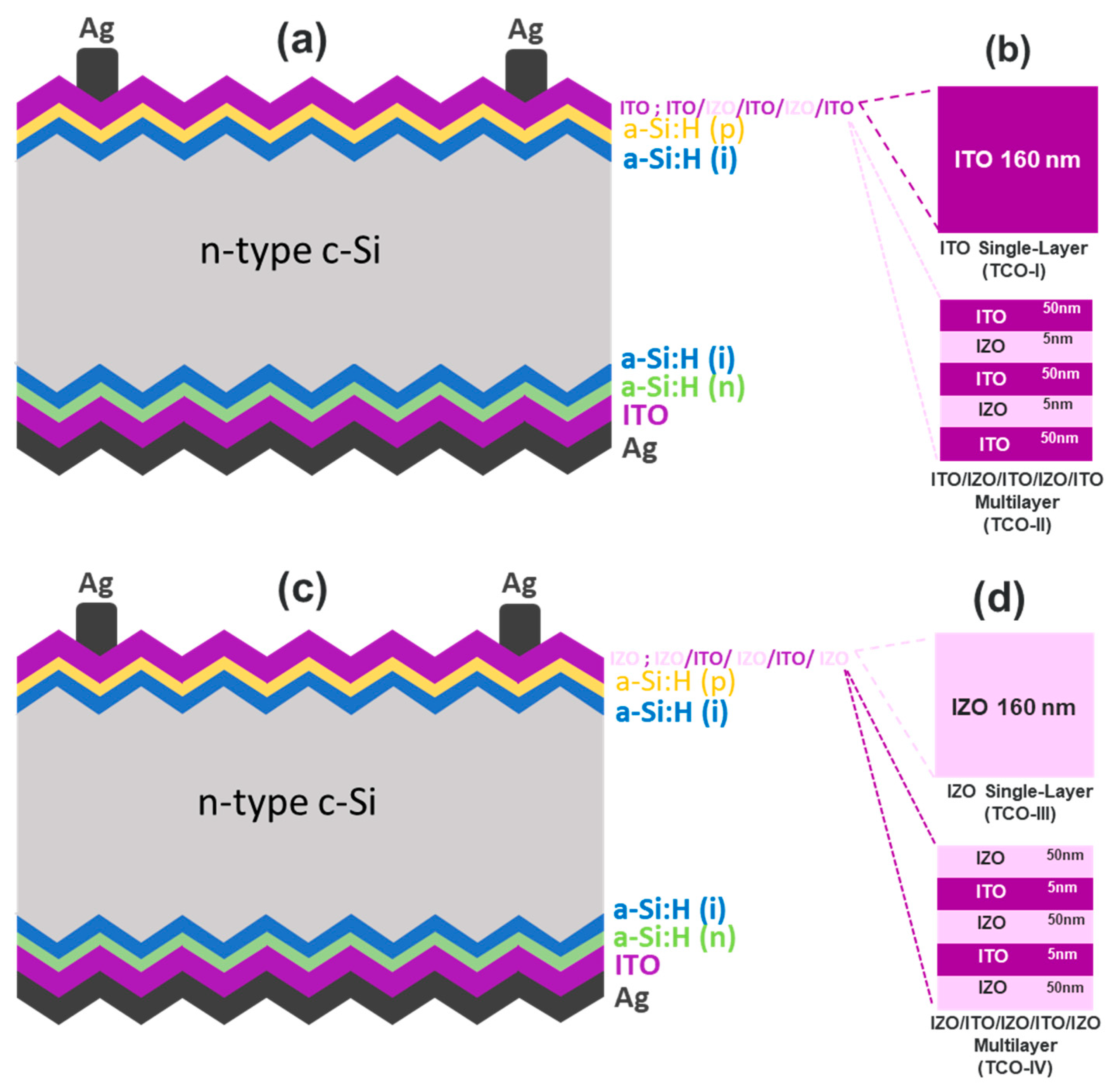
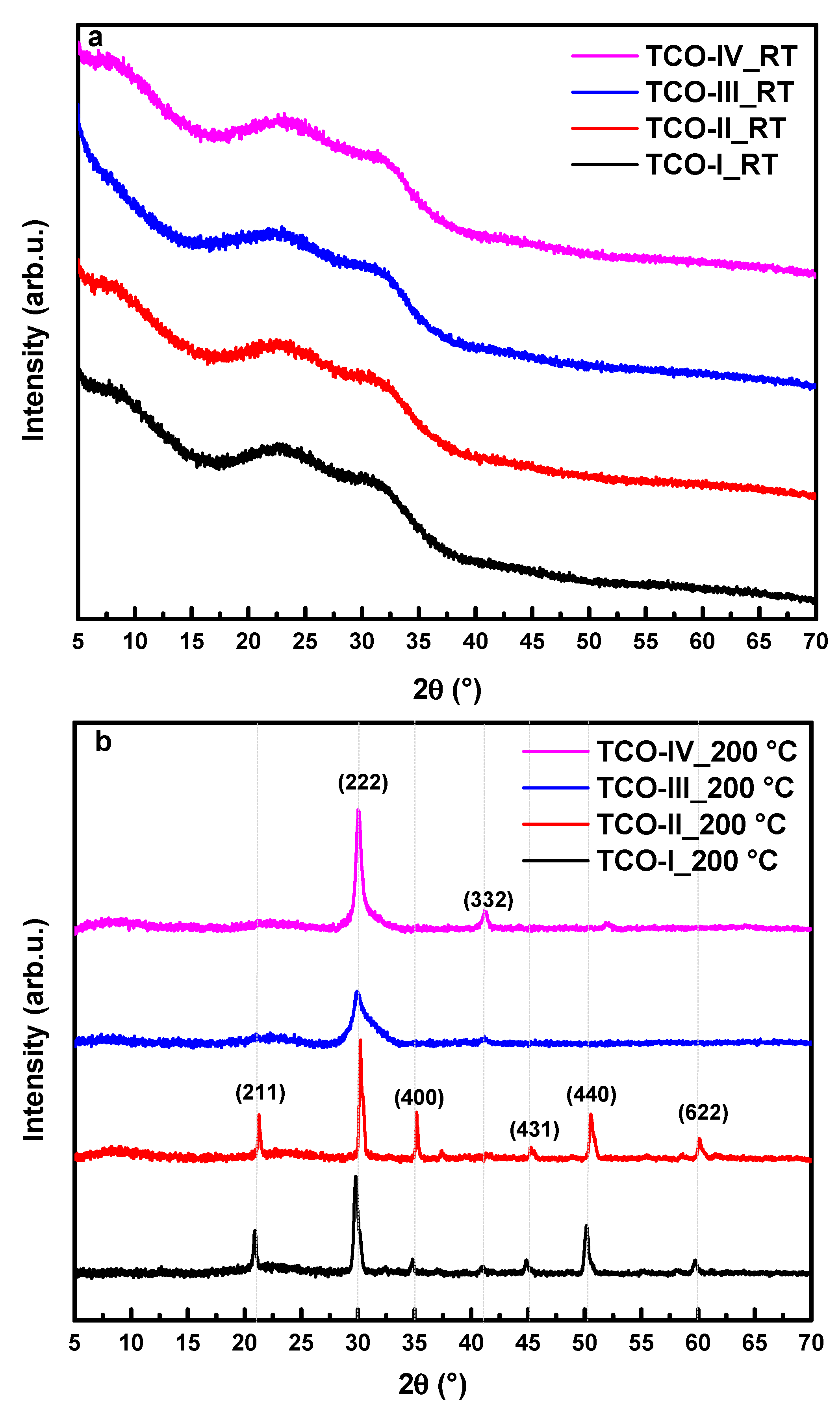

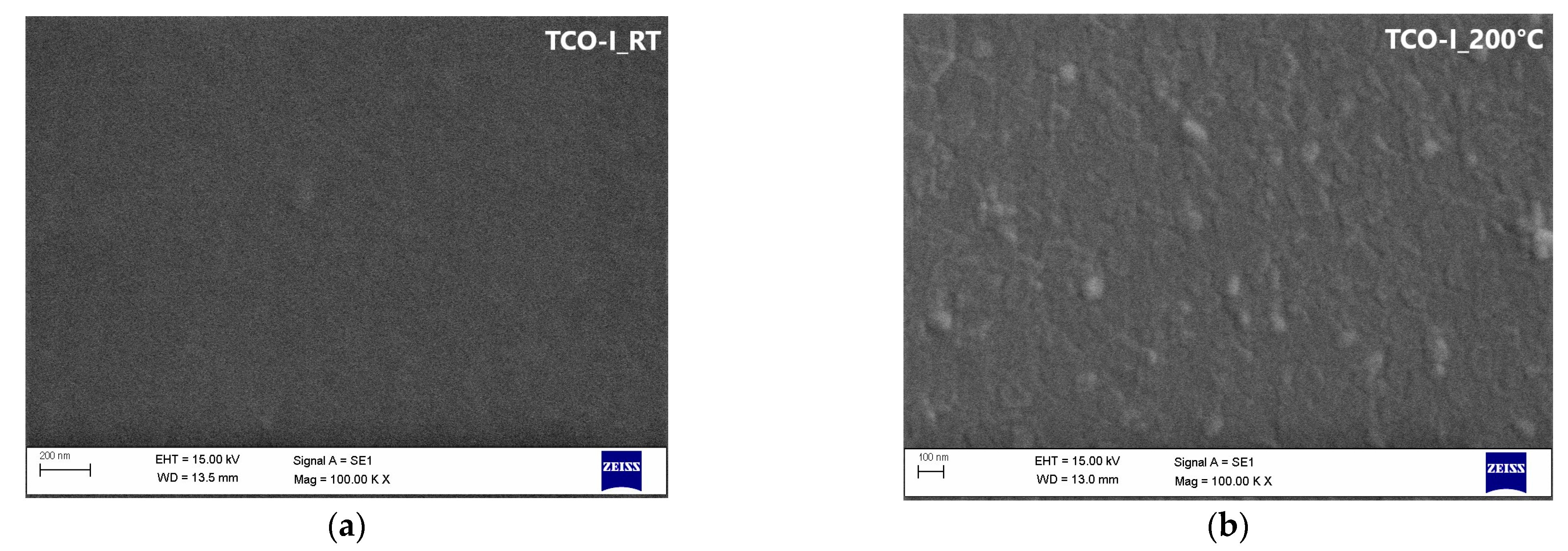
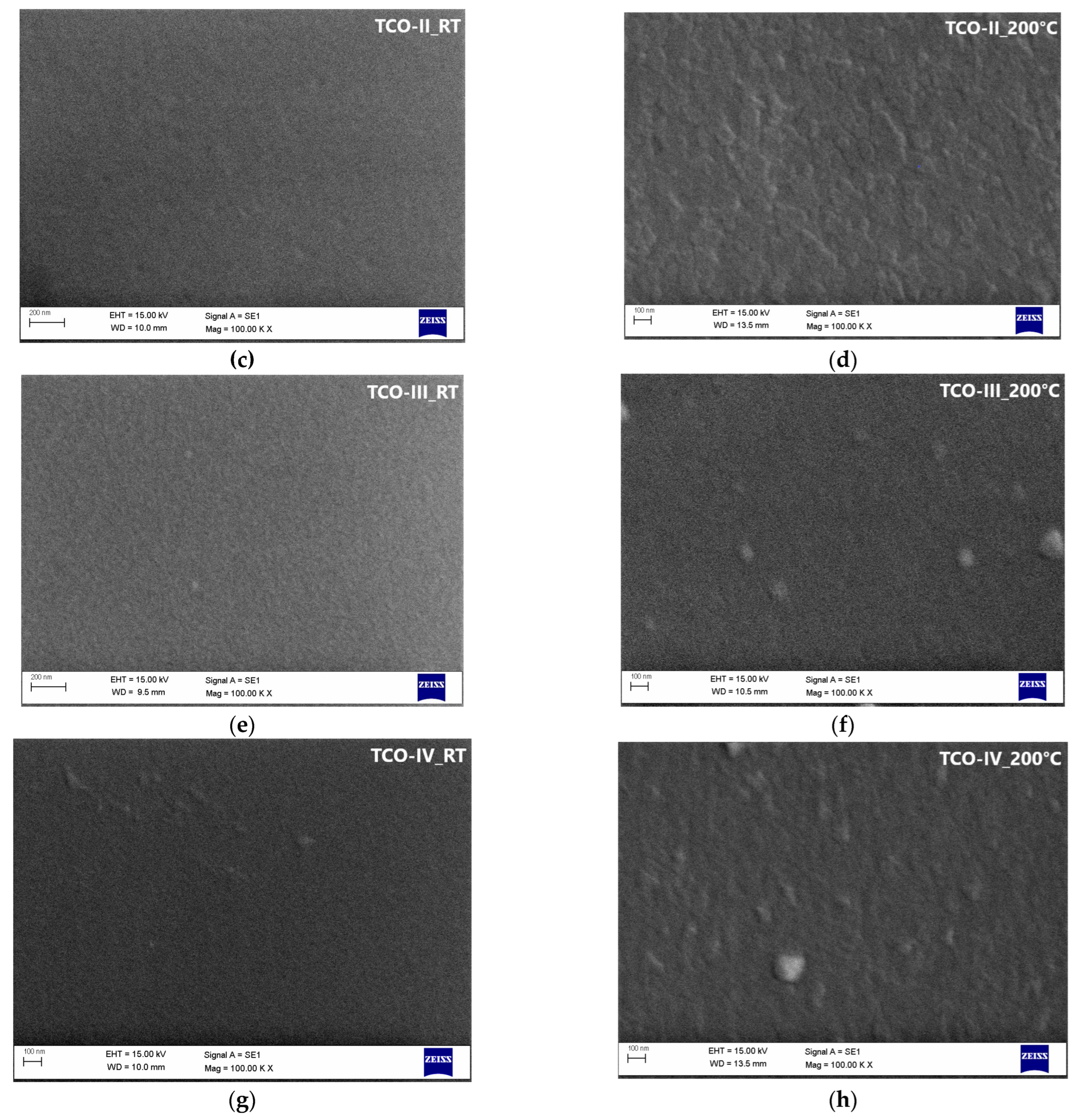

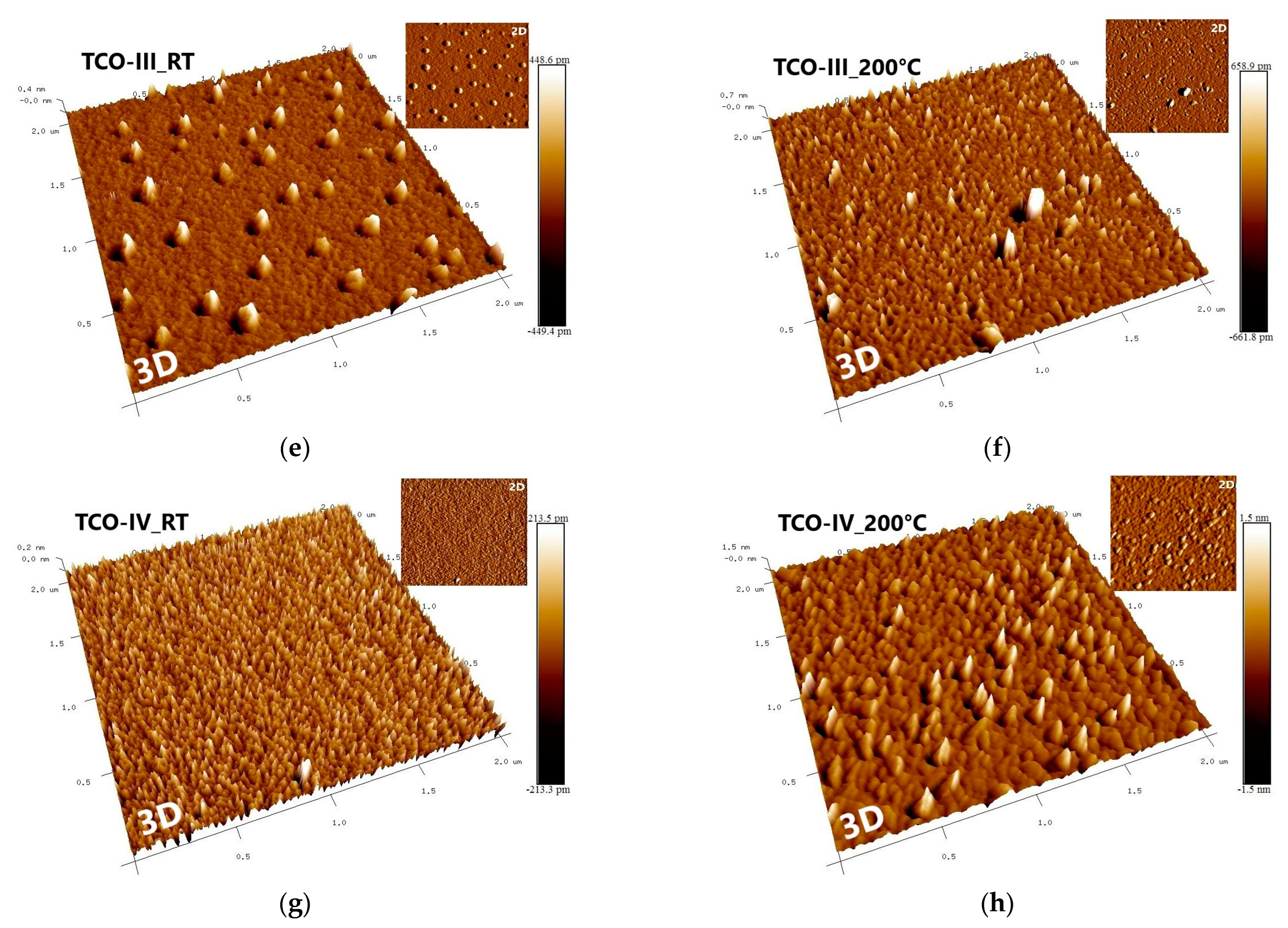
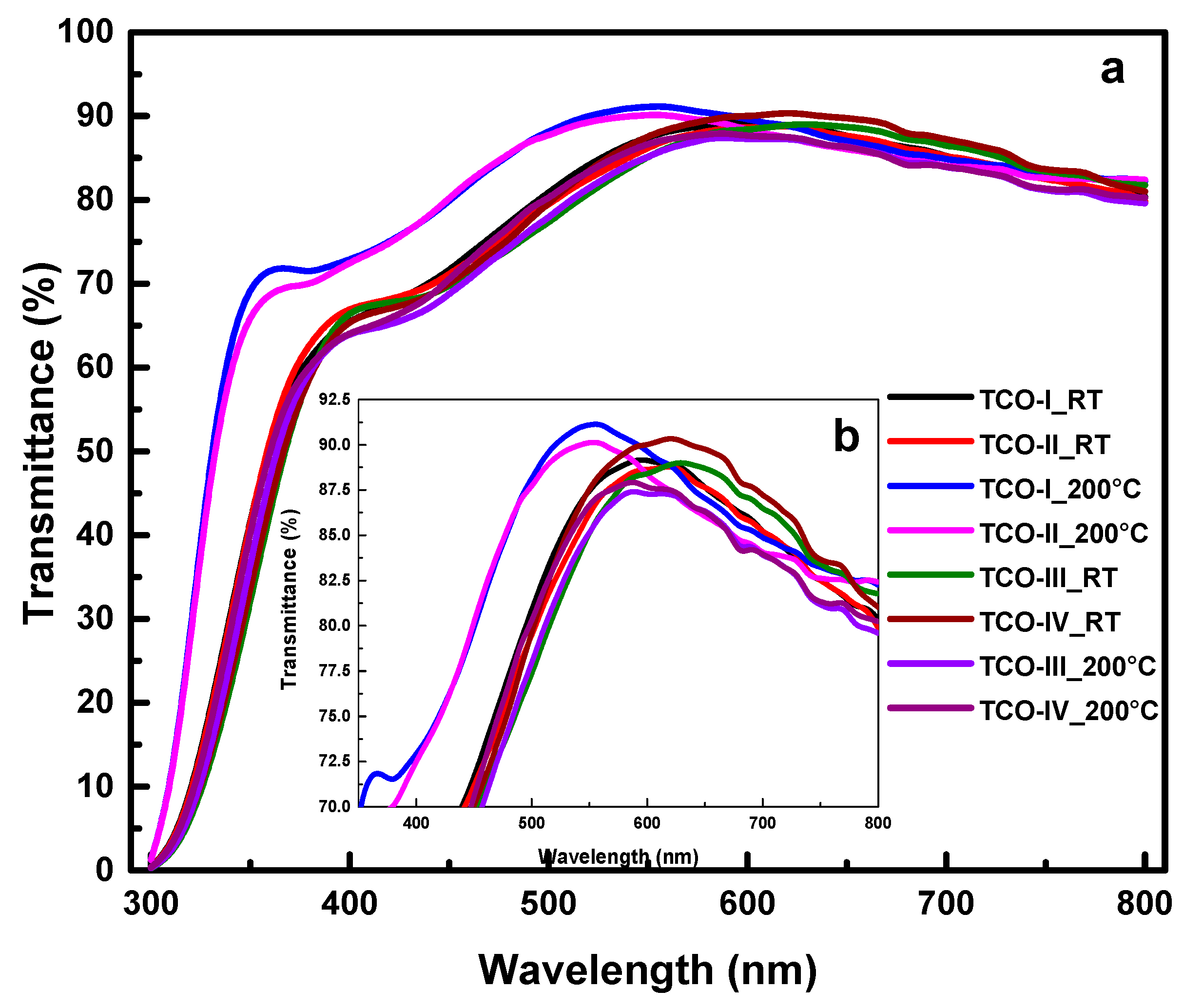
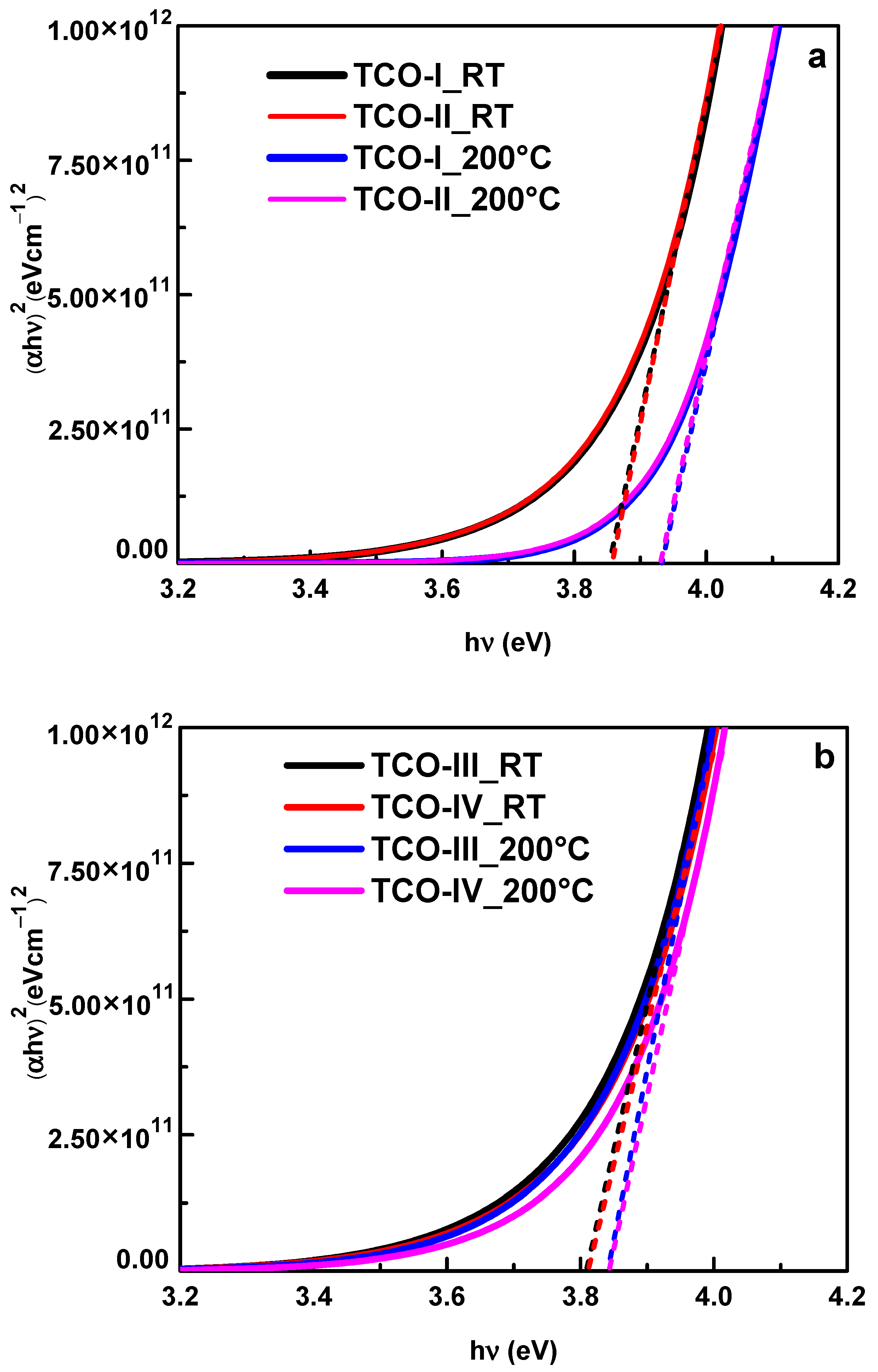
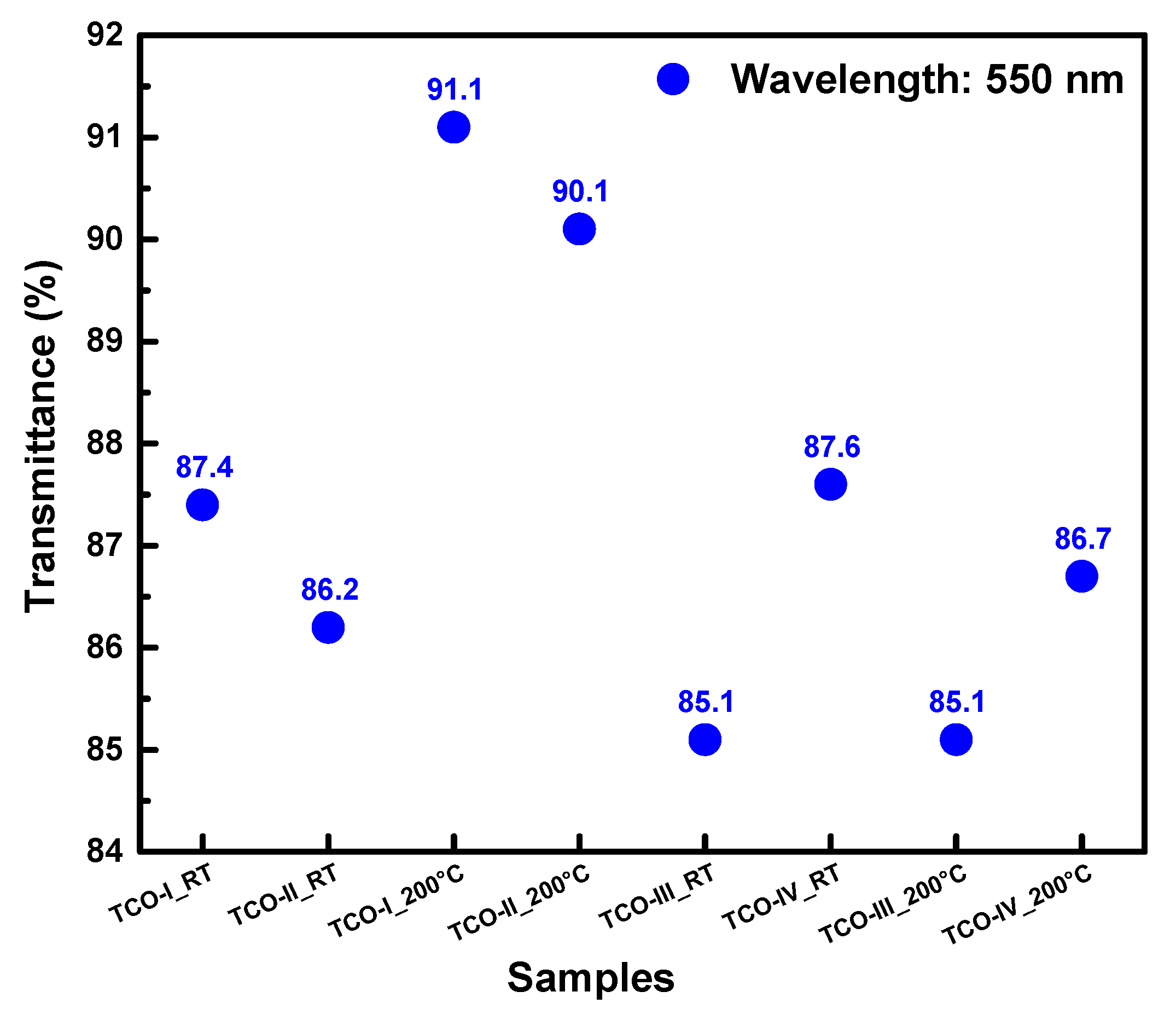
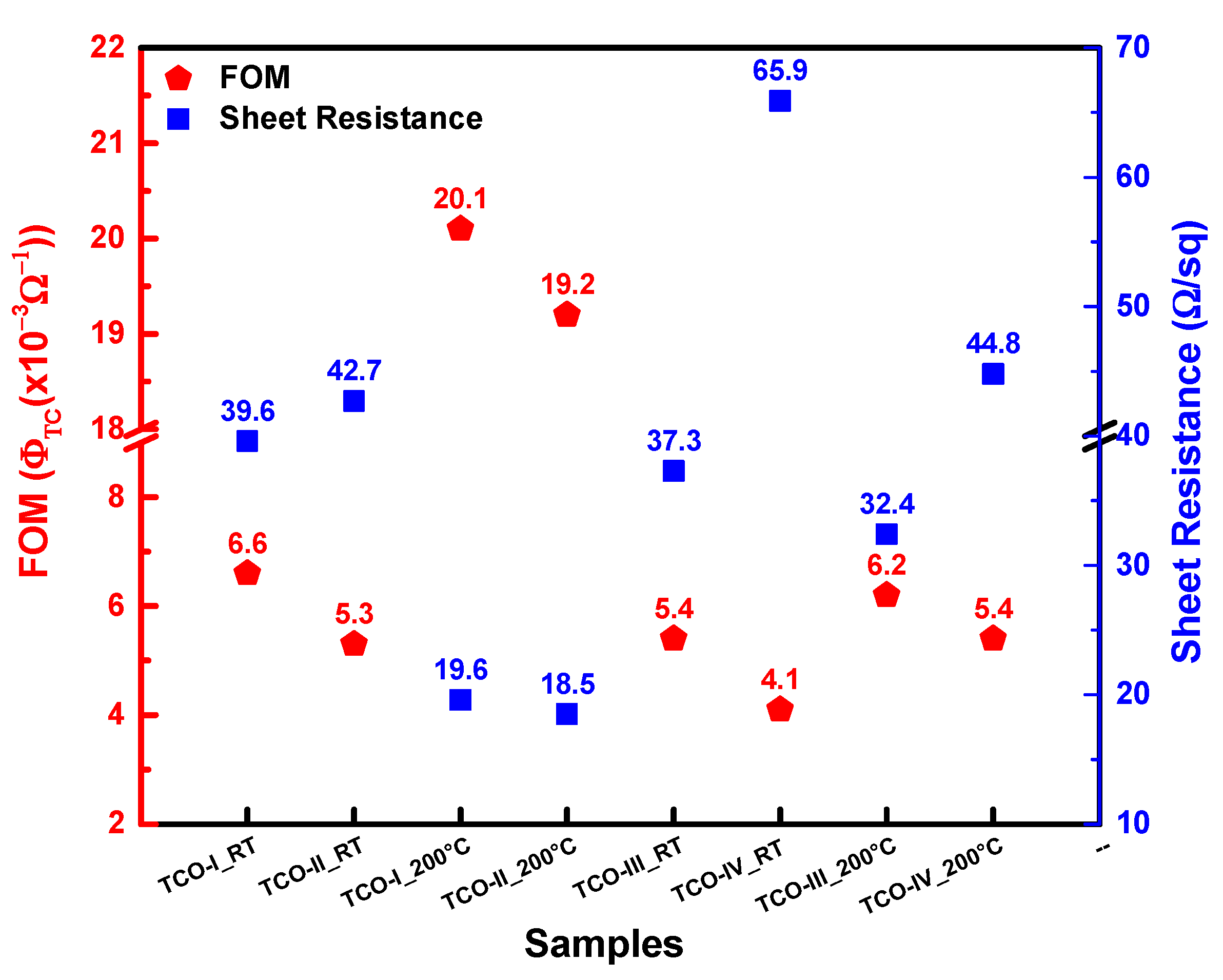
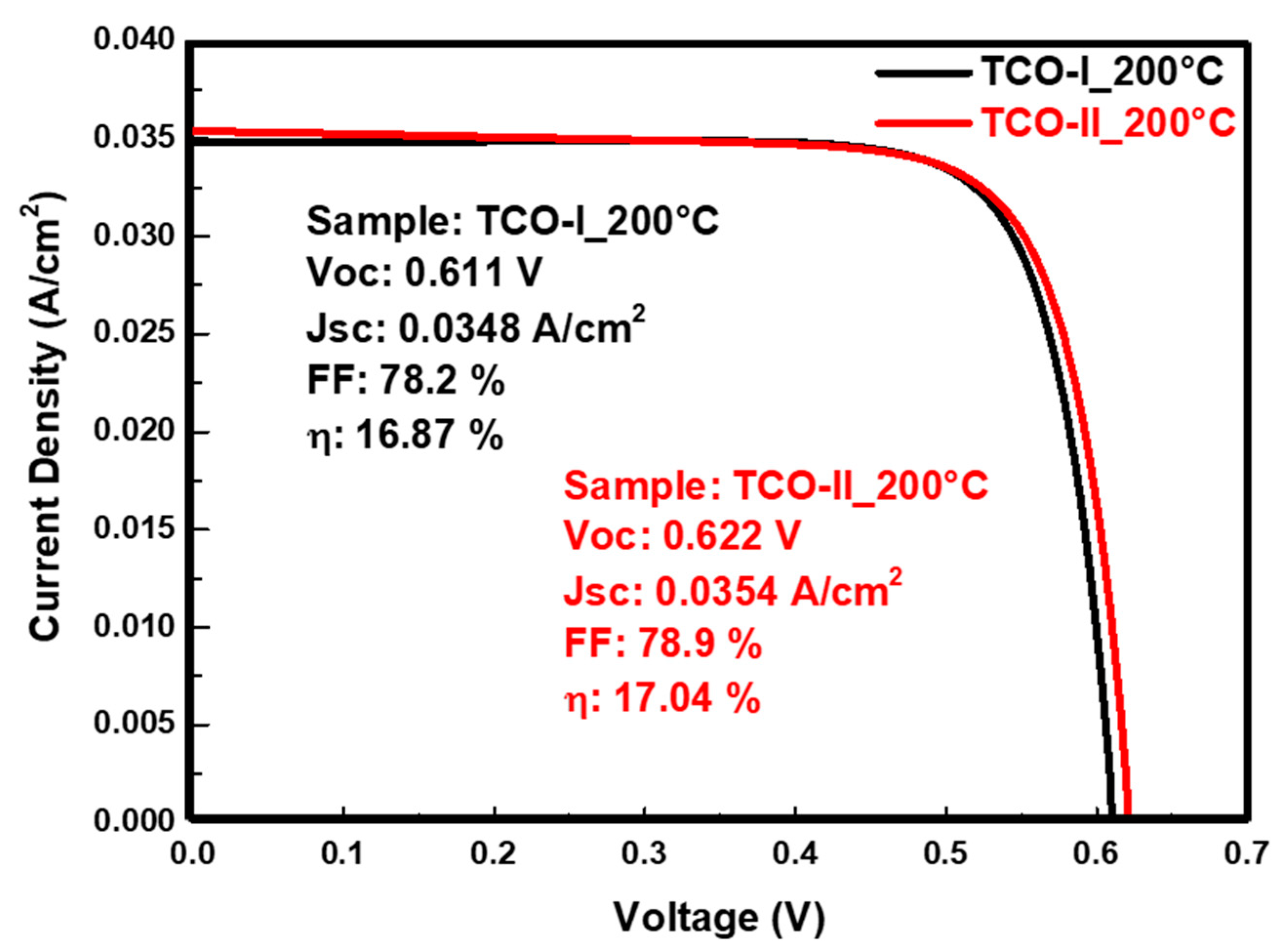
| Parameter | TCO-I | TCO-II | TCO-III | TCO-IV |
|---|---|---|---|---|
| Base pressure (Torr) | 1 × 10−6 | 1 × 10−6 | 1 × 10−6 | 1 × 10−6 |
| Deposition pressure (Torr) | 9 × 10−4 | 9 × 10−4 | 9 × 10−4 | 9 × 10−4 |
| Ar pressure (mTorr/sccm) | 5/2 | 5/2 | 5/2 | 5/2 |
| Deposition temperature (°C) | RT-200 | RT-200 | RT-200 | RT-200 |
| Rotation speed (rpm) | 8 | 8 | 8 | 8 |
| Set power (W) | 75 | 75 | 75 | 75 |
| Thickness (nm) | 160 | 50/5/50/5/50 | 160 | 50/5/50/5/50 |
| Deposition rate (Å/s) | 0.8 | 0.8/0.9 | 0.9 | 0.8/0.9 |
| Samples | D (nm) | ε (×10−3) | δ (lines/nm2) | N (nm−2) |
|---|---|---|---|---|
| TCO-I_200 °C | 17.51 | −1.09 | 3.26 × 10−3 | 2.98 × 10−2 |
| TCO-II_200 °C | 35.02 | 1.27 | 8.15 × 10−4 | 3.73 × 10−3 |
| TCO-III_200 °C | 1.15 | −79.53 | 7.56 × 10−1 | 1.05 × 102 |
| TCO-IV_200 °C | 6.23 | −9.77 | 2.58 × 10−2 | 6.62 × 10−1 |
| AFM Results | Transmittance | ||||
|---|---|---|---|---|---|
| Samples | Rmax (nm) | Rq (RMS) (nm) | Ra (nm) | Eg (eV) | Average (%) (400–800 nm) |
| TCO-I_RT | 1.21 | 0.0512 | 0.0397 | 3.85 | 82.1 |
| TCO-II_RT | 1.50 | 0.0625 | 0.0438 | 3.85 | 81.7 |
| TCO-I_200 °C | 7.38 | 0.307 | 0.209 | 3.93 | 85.1 |
| TCO-II_200 °C | 3.86 | 0.330 | 0.219 | 3.93 | 84.5 |
| TCO-III_RT | 1.41 | 0.0642 | 0.0515 | 3.81 | 81.6 |
| TCO-IV_RT | 2.50 | 0.0617 | 0.0477 | 3.81 | 82.5 |
| TCO-III_200 °C | 9.98 | 0.214 | 0.109 | 3.84 | 80.2 |
| TCO-IV_200 °C | 4.51 | 0.297 | 0.226 | 3.84 | 80.9 |
Disclaimer/Publisher’s Note: The statements, opinions and data contained in all publications are solely those of the individual author(s) and contributor(s) and not of MDPI and/or the editor(s). MDPI and/or the editor(s) disclaim responsibility for any injury to people or property resulting from any ideas, methods, instructions or products referred to in the content. |
© 2023 by the authors. Licensee MDPI, Basel, Switzerland. This article is an open access article distributed under the terms and conditions of the Creative Commons Attribution (CC BY) license (https://creativecommons.org/licenses/by/4.0/).
Share and Cite
Seyhan, A.; Kartal, E. Optical, Electrical and Structural Properties of ITO/IZO and IZO/ITO Multilayer Transparent Conductive Oxide Films Deposited via Radiofrequency Magnetron Sputtering. Coatings 2023, 13, 1719. https://doi.org/10.3390/coatings13101719
Seyhan A, Kartal E. Optical, Electrical and Structural Properties of ITO/IZO and IZO/ITO Multilayer Transparent Conductive Oxide Films Deposited via Radiofrequency Magnetron Sputtering. Coatings. 2023; 13(10):1719. https://doi.org/10.3390/coatings13101719
Chicago/Turabian StyleSeyhan, Ayşe, and Emre Kartal. 2023. "Optical, Electrical and Structural Properties of ITO/IZO and IZO/ITO Multilayer Transparent Conductive Oxide Films Deposited via Radiofrequency Magnetron Sputtering" Coatings 13, no. 10: 1719. https://doi.org/10.3390/coatings13101719
APA StyleSeyhan, A., & Kartal, E. (2023). Optical, Electrical and Structural Properties of ITO/IZO and IZO/ITO Multilayer Transparent Conductive Oxide Films Deposited via Radiofrequency Magnetron Sputtering. Coatings, 13(10), 1719. https://doi.org/10.3390/coatings13101719






